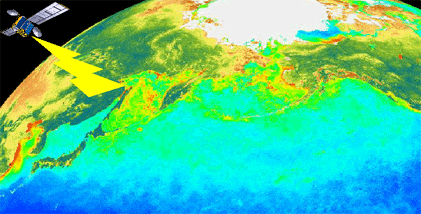|
|
|
|
Biological Oceanography

Searching for marine life from Space
A great variety of organisms, such as fish and seaweed that are vital fool resources for mankind are produced and live in the oceans. Measuring phytoplankton biomass with an Ocean Color Sensor from space is an observation technique that has recently received a lot of attention. Phytoplankton, which exists in the lower levels of the marine ecosystem, harvests the sunlight for photosynthesis. They absorb the atmospheric carbon dioxide dissolved in the seawater or supplied by the deep layers, as well as phosphorus and nitrogen, to produce new organisms (this is called primary production). All marine life relies on the biomass generated through primary production generates, and the biomass volume is said to control the total production of organic matter.
Global warming has been worsening lately, and carbon dioxide, which is increased by fossil fuel burning and deforestation, is likely to be the main cause. It is estimated that global warming is progressing because of the ivereased of greenhouse effect, which results from an increase of carbon dioxide and other heat-trapping gases in the atmosphere. The distribution of carbon dioxide on the Earth, including the role in the carbon dioxide fluctuations of the oceans that account for 70 percent of the Earth’s surface, is still not clearly understood. The oceans are constantly absorbing and releasing large quantities of carbon dioxide. The annual amount exchanged (circulating amount) is estimated to reach 100 Giga tons of carbon converted. The oceans absorb carbon dioxide generally in two ways, the dissolution pomp and the biological pomp Dissolution pump physically and chemically amount dissolves atmospheric carbon dioxide in the surface seawater. Compared to other atmospheric gases such as oxygen and nitrogen, carbon dioxide dissolves very well in water, and the lower the sea temperature and the higher the atmospheric pressure, the greater the dissoluble. The biological pump is similar to what is occurring on land where the forests absorb carbon dioxide. In this process primary production, which phytoplankton generates in the surface seawater, turns carbon dioxide into organic carbon, which is then transported to the oceanic deep layers. The partial pressure of carbon dioxide in the seawater decreases through serial processes executed by organisms in the surface seawater, and an equivalent amount of carbon dioxide can then be dissolved from the atmosphere.
Clarifying the mechanisms of the carbon cycle in the oceans, which function as the main absorption buffer of carbon dioxide, is a very important theme in forecasting the future global environment. For that reason, it is necessary to understand the movement of the phytoplankton in the oceans, and to quantify how primary production fluctuates. In addition, phytoplankton will provide a standard tool for measuring ocean productivity since it feeds many fish species such as sardines and tuna through the food chain.
The GLI sensor onboard ADEOS-II, which is scheduled to be launched soon, will provide multi channel data acquisition and 250m high-resolution capabilities inherited from successful OCTS. It will measure phytoplankton concentration, primary production, and their fluctuations over large areas. It is expected that continuous observation over long periods of time will contribute to the understanding of the mechanisms that control fluctuations in the global environment, and applications such managing of fishery resources.

|
|
|
|
Comments to:

|